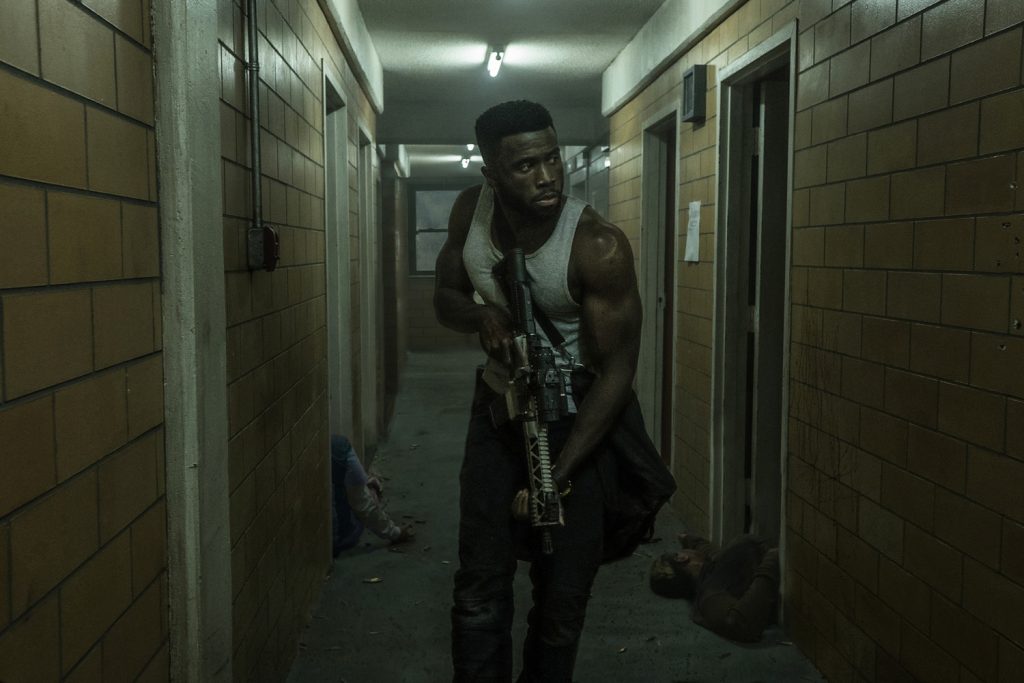It’s been five years since the world first experienced the provocative concept of The Purge, when, for one night during the year, all crime—including murder—became legal. Electrifying the culture with its dystopic premise, the home-invasion thriller The Purge spawned a franchise that explored the madness that seeps into our everyday lives. Unleashed in the streets in 2014’s electric The Purge Anarchy, and explored through America’s electorate in 2016’s political conspiracy The Purge: Election Year, each film seemed to be a harbinger of just how dangerous and brutal we could become.
When discussing the director who should take the reins for the prequel, The First Purge, James DeMonaco, who created the first three films, and his fellow producers—were drawn to Gerard McMurray, known for his visually stunning inaugural cinematic work. DeMonaco had written this tale to serve as prequel to his other films, and felt it would be interesting and timely to set the events in 2018.
McMurray offers that the premise behind The First Purge spoke to him on multiple levels. As it does for many, this genre lets us wrestle with the evils of the real world. “Horror movies take what seems too scary in real life and turn ideas into a boogieman—a monster, a metaphor that we can confront and maybe conquer,” reflects the director. “The Purge franchise has sustained because it has something to say about the world we’re living in. This time we’re going to take you back to how it all began with how an isolated social experiment turned into something unimaginable.”
The worst and most terrifying of those monsters is mankind itself. DeMonaco created this series as an allegory, asking audiences: “What if we ended up in this kind of world? What if our government was trying to force us to tear each other apart and destroy the most vulnerable in society? Would I join in as a participant, or would I fight the machine itself?” McMurray is emphatic: We’re fighting the machine.
He also has a deep desire to tell stories about people who have been all-too-long relegated to supporting players. With the burgeoning renaissance in cinema that speaks to multifaceted aspects of the Black experience—from Get Out and Moonlight to Straight Outta Compton and Black Panther—there’s a deep hunger by underrepresented audiences to hear their voices and see their stories on screen…in all genres.

A longtime fan of horror, McMurray felt this was the prime opportunity to make a unique film that underscored under-representation with episodes of systematic repression. Particularly interesting was the idea of telling the tale of The First Purge as a uniquely personal one. DeMonaco had woven a story of primarily African-American and Latino characters who were all interconnected in their Staten Island community. With ex-lovers Dmitri and Lex forced to come together during their city’s time of need, they had to put aside heartbreak and champion one another.
Yes, this Purge is definitely more political than the previous chapters, admits the director proudly. “Coming in as a filmmaker of color, I really wanted to address the political issues head on. I think some issues in society that we’re facing now speaks to The Purge. By grounding this film in reality, I knew I could tell a more nuanced story of this Purge and get audiences to understand why it all happened from the beginning and what people did—as well as why the idea of this is so close to what we are right now as a society. I allowed myself to hone in and tell a story that was more intimate for audiences…while also giving them big action-horror pieces along with it.”
In Philippine cinemas August 22, The First Purge is distributed by United International Pictures through Columbia Pictures. Follow us on Facebook.

